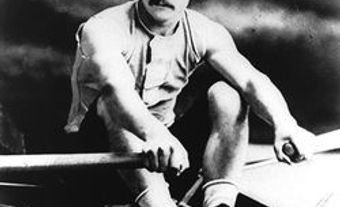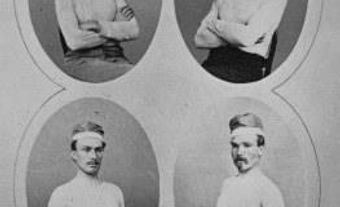Ned Hanlan
Edward "Ned" Hanlan, sculler, (born at Toronto 12 Jul 1855; died there 4 Jan 1908.) Ned Hanlan was the first Canadian athlete to be world champion in an individual event and the first Canadian athlete to gain international recognition. Hanlan grew up on the western peninsula of Toronto Island that came to bear his name, as Hanlan's Point. He was only five years old when the newspapers reported that he rowed across Toronto bay to watch the arrival of the Prince of Wales. He was 16 when he entered his first rowing competition and in 1873 he won the championship of Toronto bay.
Ned Hanlan's Rowing Career
Three successive victories over the local champion Thomas Loudon led a group of Torontonians in 1876 to form the Hanlan Club to back Hanlan as a professional. The club bought him an English-made shell and equipped it with a sliding seat and swivel oarlocks. These recent innovations had been available to others but Hanlan was the first to master them. (The swivel oarlock was invented in 1874 by an American. "Sliders" were used on the Tyne in England in the early 1870s.) Hanlan's mastery of these innovations resulted in a long, fluid stroke, very similar to that of today's scullers. His ability to co-ordinate the power of his whole body enabled him to defeat much larger opponents. (Hanlan was only 1.75 metres tall [5ft 9] and he weighed a mere 68 kilograms [150 lbs].)
Rowing was a popular spectator sport in the 19th century, and races attracted heavy betting. Thousands watched Hanlan wherever he rowed, vanquishing most of North America's best rowers, while collecting generous prize money and winnings for those who bet on his success.
Hanlan won the Canadian championship (and stakes of $1000) in 1877, out-rowing New Brunswicker Wallace Ross in front of 25 000 spectators in Toronto bay. The following year he took the American title from Ephraim Morris of Pittsburgh on the Allegheny River. Finally in 1879 he captured the English championship, beating William Elliott by 11 lengths over a 5.6 km stretch of the Tyne.
Ned Hanlan achieved his last goal on 15 November 1880, when he easily beat Australian world champion Edward Trickett on the Thames River, London, cheered by 100 000 spectators crowded along the embankment. This feat made Ned Hanlan Canada's first world sporting champion in an individual event. (Four New Brunswick rowers won an international regatta in Paris in 1867. (See sports history.) News of Hanlan's success unleashed an outpouring of national pride among English-speaking Canadians.
Hanlan reaped a considerable income from his success. In 1878, he won $10000 when he defeated Charles Edward Courtney at Lachine, Que, and another $6000 when he beat Courtney again in Washington, DC. Hanlan defended his world title against another Australian, Elias C. Laycock, on the Thames in 1882, then against Englishman R. W. Boyd and again against Trickett.
Hanlan's popularity, celebrity even, resulted as much from his showmanship as from his rowing. He often toyed with opponents, slowing down, taunting them, blowing kisses at spectators, faking collapse or rowing in zigzags. (The English press lectured him sternly for his flamboyance.) He was easily Canada's "first national sporting hero," at least in English Canada. After his first English triumph he was met back home by a flotilla 5 kilometres long. In New South Wales a town was renamed Toronto in his honour. He endeared himself to Torontonians by stressing his Canadian identity. He actively took part, like any celebrity today, in numerous promotions, particularly in whistle-stop autograph tours on the eve of races. He organized his own touring shows, raced local heroes, and indulged in showboating, performing tricks such as rowing in a straight line with only one oar.
Hanlan finally lost his world title 16 August 1884, to Australian William Beach in a race near Sydney. Unlike Hanlan's other challengers, Beach had also mastered the use of the sliding seat and he outweighed the Canadian by 23 kilos. Hanlan lost to Beach 7 months later and again in 1887. Despite losing his American title to John Teemer in 1885, he continued to race and to draw large crowds to his exhibitions for another decade. During his rowing career, Ned Hanlan won more than 300 races, including exhibitions, and suffered fewer than a dozen defeats.
Ned Hanlan's Political Career
In 1880, Hanlan had purchased a lease for the 1.2 hectare point near his family home on Toronto Island and built a picturesque hotel to which he attracted customers with a variety of events and amusements. He sold his hotel in 1892 and moved his family to the mainland on Beverley Street. He retired from competition in 1897 and did some coaching. In 1898 he ran for alderman, winning a seat in Ward 4, and was appointed to the Toronto Harbour Trust. He was outspoken about issues concerning the waterfront and public recreation, advocated bicycle paths on the island, bike lanes in the city, a new public library, and public swimming pools. Although re-elected in 1899, Hanlan lost his position on the harbour trust after condemning it for its roll in sewage being dumped in the lake and for its neglect of the breakwaters . He lost his seat in 1900 and spent the rest of his life in retirement. He was only 52 when he died of pneumonia. Some 10 000 people paid their respects, filing past his coffin in St Andrew's Church, and tributes flowed in from around the world. In 1926, the City of Toronto dedicated a statue of Ned Hanlan by Emanuel Otto Hahn, on Toronto's waterfront, on the grounds of the Canadian National Exhibition. The 6-m bronze statue was moved to Hanlan's Point and rededicated in September 2003.

 Share on Facebook
Share on Facebook Share on X
Share on X Share by Email
Share by Email Share on Google Classroom
Share on Google Classroom





